The Frederick H. Withycombe Story
by W. Eric Halpin
Reprinted from "Crown Jewels of the Wire", August 1987, page 19
As the research began for this article on Mr. Withycombe and his ridged
insulators, I very quickly ran into a major stumbling block. To put it quite
simply, very little is known about the man other than the following last
Montreal telephone business directory listing in 1908:
' WITHYCOMBE, F.H., 25
JURORS ST. NEAR BLEURY. MECHANICAL ENGINEER AND EXPERT MECHANIC. HIGH CLASS
MACHINE WORK, INVENTORS MODELS. MECHANICAL, ELECTRICAL AND SCIENTIFIC APPARATUS
DESIGNED, MADE AND REPAIRED.'
Despite placing newspaper advertisements, writing
various government and educational agencies and scouring dozens of present day
telephone directories, I have been unsuccessful in locating any relative,
friends or associates of his. It was initially planned that I could open some
new insights into the man who designed a present day, very popular collectable
insulator. His insulator, I believe, is more popular today within the hobby than
it ever was within the telegraph industry at the turn of the century.
Frederick
Henry Withycombe paid $20 and applied for a Canadian patent for 'electric
insulators' in July, 1898. This Canadian patent #63026 was issued in May, 1899.
Mr. Withycombe also applied for American patents for 'electric insulators' in
February, and September, 1899, and patents #633173-#633176, plus design patents
#31798-#31799 were issued in September and November, 1899 respectively. Both
American and Canadian patent applications ware essentially the same, except that
in Canada seven design concepts were covered under one patent issue. The
Canadian patent documents went into a little more detail on each design, but
overall there was little difference between them. The drawings supplied with the
patent applications were clearly modeled after the standard Canadian telegraph
insulator of the day, now known as the CD-143. However, in his applications, he
fully intended the idea of the surface
projections to be covered under patent rights
regardless of the insulators "general design or material". That is why
his ridges have been found on other insulator styles which will be discussed
later on in this article.
Referring to figure #1, of Withycombe's patent
drawings, a CD-143 with 11 horizontal ridges above and 8 horizontal ridges below
the wire groove is shown. The groove cutting across the insulators ridges was
intended, according to patent data, "to provide for the flow of moisture
from the insulator". No exact example of this insulator is known to exist.
Figure #2 patent drawing is a CD-143 with 24 oblique ridges above and below the
wire groove. No example of this insulator is known to exist. Figure #3 patent
drawing is a CD-143 with 48 vertical ridges above and below the wire groove.
This insulator is known to exist with 50, 52, 53, and 54 ridges (refer to photo
#1). The American patent drawings for figures #2 and #3 differed from the
Canadian, in that the ridges continued down to and under the base forming wedge
shaped drip points (refer to figures #8, #9, and #10). Figure #4 patent drawing
is a CD-143 with 11 spiral ridges above and 8 spiral below the wire groove; both
with a right hand thread pitch to the ridges. No exact example of this insulator
is known to exist, but there are several similar styles (refer to photos' #2, #3, and
#4).
Figures #5 and #6 patent drawings show two CD-143's covered
with "protuberances and depressions" respectively, of varying shapes.
No examples of these insulators are known to exist. Both of these later two designs are an improbable, if not
impossible task to reproduce in a mold. Note that in figure #6, the irregular
figures are not cut into the mold body but formed on the inside surface of the
mold, thus giving it a more slender appearance. Figure #7 patent drawing shows a
CD-143 identical with figure #1 drawing except for the absence of the drainage groove across the ridges. A very similar
insulator exists (refer photo #5).
Before proceeding, I should comment on the
minor problem of counting ridges. On some styles the dome crown ridges become
very weak and some people don't count them. However, I do count this weak ridge
area. Depending on what side of the dome you count the ridges on (left or right), can make a difference of one ridge count on patent drawing #4. I count the
side with the most ridges. On an insulator with ridges with a right hand thread
pitch, I count on the right or dominant side. Further adding to the confusion,
is that it is very easy to miscount ridges, especially on the vertical ridge
styles. This is why different ridge counts are sometimes reported by collectors.
Now lets take a look at some real live Withycombe insulators. Photo #1 shows
a CD-143 vertical ridged insulator with 50 ridges. Other then ridge count, the
52, 53, and 54 ridged varieties are almost identical. The 52 ridged variety
seems to have a more flattened crown top. These insulators were obviously modeled after patent drawing figure #3. These insulators are found primarily in
aqua, but green and blue color tones exist. They have been found across Canada
on C.P.R lines.
Photo #2 shows a CD-143 (MLOD) with 24 ridges (14 circular
ridges above and 10 spiral ridges below the wire groove). The spiral ridges
have a special feature; that is, they are a double left handed thread pitch.
These ridges are actually formed by one thread starting at each mold line and
winding down the skirt. Thus the ridges are double threaded in the same concept
as the CD-143 with the double threaded pinhole. It seems that this light green
insulator was used in western Canada on C.P.R lines.
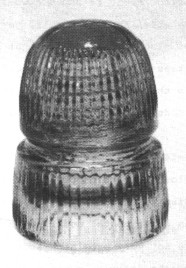
Photo #1 |
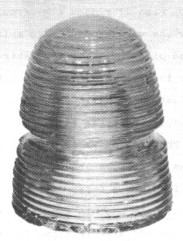
Photo #2 |
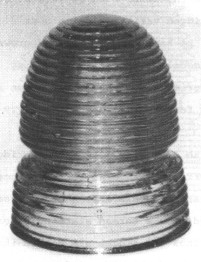
Photo #3 |
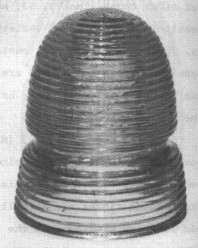
Photo #4 |
Photo #3 shows a CD-143 (MLOD) also with 24 ridges (16 circular ridges above
and 8 spiral ridges below the wire groove) . The spiral ridges have a single
right hand thread pitch. Photo #4 shows a CD-143 (MLOD) with 27 ridges (19
circular ridges above and 8 spiral ridges below the wire groove). The spiral
ridges also have a single right hand thread pitch. Both of the later two varieties
have been found on C.P.R lines in eastern Canada, and both come in the
gray and sca color tones. The last three varieties were apparently modeled after
combining patent drawings in figures #4 and #7.
Photo #5 shows an extremely rare
CD-143 (MLOD) with 21 circular ridges (11 ridges above and 10 ridges below the
wire groove) . I believe this item was a first attempt by a Canadian glass
company to reproduce Withycombe's patents and may have been an experimental
model not intended for distribution. The ridges are not very prominent above the
wire groove and certainly not what Withycombe desired in his ridged insulators.
In fact these ridges only extend about two-thirds of the way up the domes side.
This aqua insulator was modeled after patent drawing figure #7, and is the only
type of CD-143 with circular ridges below the wire groove. Examples of this insulator exist in only three
separate insulator collections and all were originally located on a C.P.R spur
line in the western Canadian province of British Columbia.
Photo #6 shows a
fairly common Withycombe style CD-143 with 69 vertical ridges above and 9 spiral
ridges below the wire groove. The spiral ridges have a single left hand thread
pitch. These spiral ridges were cut into a former 'CANADIAN PACIFIC RY CO' mold
and the remains of this embossing can still be clearly seen. This variety was
modeled by combining patent drawings #3 and $4. This insulator is usually found
in a bluish-aqua color but a light purple color tone does exist. More of these
insulators were made then any other CD-143 style but they were still not a high
production item. This variety has been found across Canada on C.P.R lines. I
date this insulator from around the 1917 period after all of Withycombe's patent
rights had expired in Canada.
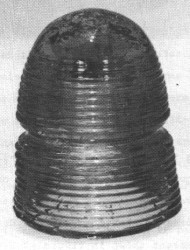
Photo #5 |
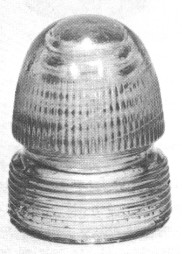
Photo #6 |
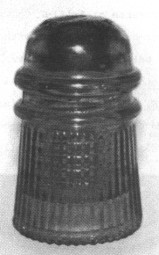
Photo #7 |
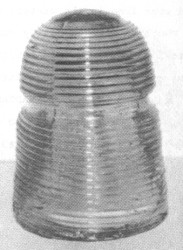
Photo #8 |
Photo #7 shows another Withycombe ridged insulator, the CD-121. This
insulator has the American Withycombe patent date embossed on the dome (PAT'D
SEPT 19th, 1899). The 44 vertical ridges, forming pleats around the skirt,
continue under the base to each form a wedge drip point. Thus it was modeled on
design patent shown in figure #8 with base in figure #10. It is found in varying
color tones of aqua, blue, and green and only on some eastern and central
American phone lines.
Photo #8 shows the last of the Withycombe ridged style of
insulator, the very scarce CD-144 also called the high groove Withy. This 27
ridged insulator (MLOD) has 11 circular ridges above and 16 spiral ridges below
the wire groove respectively. The spiral ridges have a quadruple left hand
thread pitch. That is, the spiral ridges are actually formed by 4 separate
ridges starting below the wire groove (one at each mold line and one at each
side of the skirt center). This insulator seems to have been found only in parts
of western Canada (British Columbia and Alberta). It comes in a light green
color tone and if memory serves me correctly, a light purple tone also.
So there you have it; of Withycombe's nine different ridge patent styles,
eleven different insulators have been manufactured and attributed to his patent
ideas. But what are the ridges for? Withycombe stated in his patent application
"to render insulators of whatever form, less liable to breakage by
providing a simple and efficient means to enable them the better to withstand
the impact of foreign bodies". "The breaking down of the intercepting
parts (ridges), cushions the blow and relieves the main portion or body of the
insulator from the full severity of impact". Mr. Withycombe further
determined by "tests" that for the ridges to be effective they must
"be of greater height than thickness" unfortunately in actual practice,
many of the ridge designs did not come out all that high or thin. Thus it is
unclear just how effective they actually were.
A sometimes discussed design
weakness of the ridged insulators is that they would have a tendency to collect
and retain dirt, soot, and moisture to a greater degree than a more uniformed
shaped surface. I have never picked any that were particularly dirty, but then
again I have never seen these in built-up industrial or urban areas anyway. And
that is where they were intended to be used, to thwart the efforts of bad boys
with sling shots, etc. I have found these insulators in some very remote and
isolated parts of Canada and still they were damaged, especially the types in
photo's #2 and #6.
While Mr. Withycombe clearly understood the need to promote
water drainage from the insulators surface, the ridges both horizontal and
spiral still retained water droplets. Thus under certain weather conditions of
freezing rain or ice/snow thaw and refreeze; I believe many of the ridges were
damaged. Not by projectiles, but by the water freezing between the ridges
causing the necessary amount of expansion and thus ridge damage. This is
especially true on the spiral below wire groove styles. Of all the Withycombe
patents, I feel figure #3 with the vertical ridges to be the best design
concept. In actual practice, it is this type (photo #1) that true, mint
condition insulators can be found.
One of the last questions remaining on the
Withycombe insulators is who made them and when. Well several insulator
manufacturers likely did. The 00-121 has the American patent date embossed on
the dome and apparently has only been found on lines in the states. Thus, a U.S.
manufacturer (Brookfield ?) is likely to have made them between 1900 and 1914.
The Crystal Glass Company (1907-1908) in British Columbia advertised "....manufacturing all grades of glass from bottles to insulators...... one feature of
these insulators is that they have been specially ribbed....". Since so many of the
Withycombe insulators were found in western Canada and some like the CD-143
(photo #5) and the CD-144 (photo #8) exclusively in B.C. and/or southern
Alberta, it is a fair guess to attribute some if not most of the Withycombes' to
this company. Until an organized dig is conducted at the old company
site, proof
will not be available.
Finally, it would seem reasonable to associate some of
the insulators in photo's #1, #3, and #4 to an eastern manufacturer such as the
Sydenham Glass Company, but I have no evidence to support this. Years ago on a
dig at the Brookfield dump, three-quarters of a vertical grooved Withy (photo #1)
was located by another collector. It is possible, but unlikely in my opinion,
that the vertical ridged style is of Brookfield origin.
So there you have it! A
small tribute to Mr. Withycombe, by publishing for the first time, all of his
patent drawings and including appropriate photos of related ridged insulators,
again some for the first time. Many thanks not only to Crown Jewels, but to the
many collectors who assisted in some way with this article.
Photo credits to
Frank Commisso of Thunder Bay, Ont. for photos #l - #6, and Bill Lovely of Regina,
Sask. for photos #7 - #8.
| 